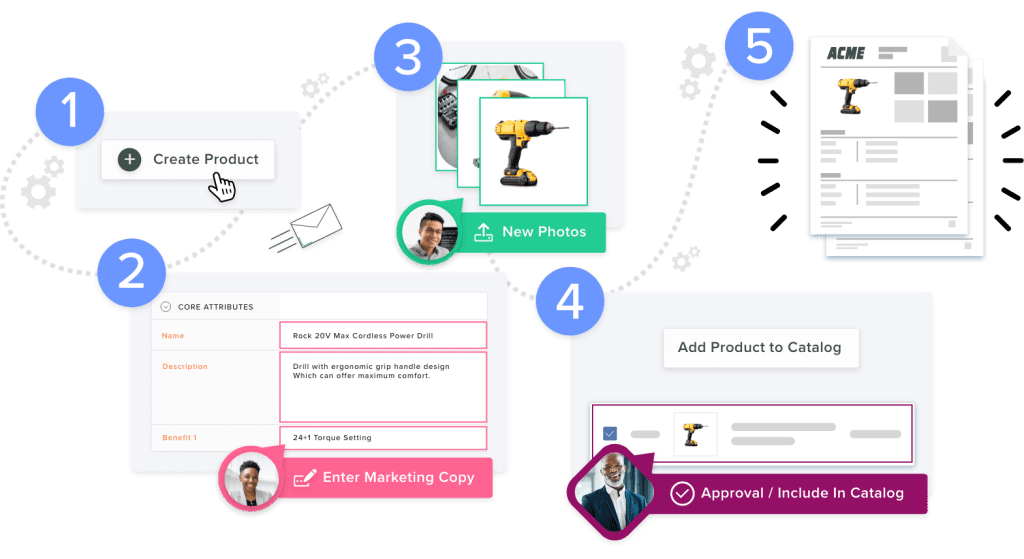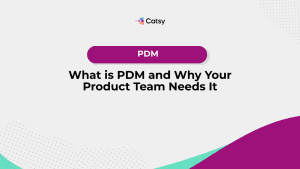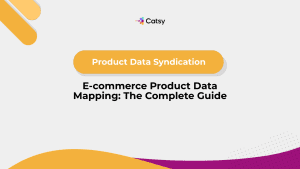Product Catalog Management for Industrial Brands

- Industrial brands often struggle with complex, ever-changing product data, complicating catalog management.
- The first step to success is consolidating product data into a single source of truth to establish consistency across channels.
- A PCM built on a PIM solution enables industrial brands to keep content updated, distributed, and optimized without struggling.
In this Article
If you are an industrial marketer, you know how valuable it is to communicate clearly. On the one hand, your decision-making process is quicker and more spot-on when you understand the issue and what needs to be done. The same is valid for industrial (business-to-business, B2B) buyers. Communicating your products’ unique selling points clearly creates real and perceived value for the audience, simplifying the purchasing process.
Product catalogs provide a crucial avenue to showcase your offerings to customers. However, keeping hundreds or thousands of attributes updated across print and digital channels is an immense challenge – details like technical specifications, images, and descriptions change constantly with new products and revisions.
When product information in catalogs becomes outdated, it causes downstream issues that hurt sales. For example, inaccurate technical details lead to compliance problems and buyers ordering wrong configurations.
Product catalog management (PCM) is a critical strategy brands can implement to solve industrial catalog headaches. For example, building a catalog from a centrally managed product information platform eliminates divergence between sources.
Some may find this concept too technical, but it’s straightforward. This post will help you understand the basics of PCM, discuss product catalog-related challenges in the B2B sector, and explain why industrial brands need product catalog management solutions.

Basics of Product Catalog Management (PCM)
What is Product Catalog Management?
Product catalog management is a comprehensive approach to managing and organizing your company’s product information. The primary goal is to ensure stakeholders can access product data that is accurate, high-quality, and up-to-date whenever they want and from wherever they are.
In industrial manufacturing, PCM systems are designed to handle the complexities of managing large volumes of product attributes, including detailed technical specifications, images, and technical data. Crucially, these systems maintain a consistent brand image, enhancing customer experience and facilitating better returns from sales activities.
A product catalog, within the PCM framework, is a structured collection of the details and assets associated with your products. Some examples of this critical data include
- Detailed specifications like materials, certifications, dimensions, and operating parameters.
- Imagery includes photos, technical drawings, diagrams, videos, and 3D renderings.
- Sales information, including brochures, target applications, options, and accessories.
- Digital assets like manuals, CAD files, and integration documentation.
How To Create A Product Catalog
Part of effective PCM is having a good grasp of creating product catalogs. This knowledge is crucial because it lays a firm foundation for a successful catalog management strategy.
Creating a product catalog involves several steps; you need specific tools to accomplish the task.

Step 1: Gather and organize product data.
Accurate and high-quality information creates a robust foundation for your catalog. Unfortunately, the reality of product data management in industrial settings is that information is often scattered in spreadsheets, ERP systems, or even paper documents.
A management tool like product information management software (PIM) consolidates these details and categorizes them into product names, SKUs, descriptions, technical specifications, dimensions, etc.
Some robust PIMs make storing and managing product information and associated digital assets easy. For example, Catsy PIM lets you manage and synchronize product attributes and digital assets from one unified platform. It unifies PIM and digital asset management (DAM) functionalities.
Step 2: Choose a creation method/tool.
Usually, you choose a product catalog creation tool or technology based on how you approach data management. For instance, if your products’ descriptions and other details reside in spreadsheets, you’ll most likely format and create basic catalogs using the platform.
For large and complicated catalogs, you can leverage tools like Adobe InDesign. This platform offers advanced layout design capabilities. However, your brand may need highly skilled professionals to produce the best design.
Creating product catalogs is easier when using PIM and DAM. For example, Catsy’s unified PIM and digital asset management system lets you create a product catalog with the latest and most complete information without human intervention. The automatic product catalog creation feature makes Catsy PIM a powerful tool. Additionally, the solution can import and export data from multiple sources, create multiple versions of your catalog, and set up automated updates. Furthermore, Catsy PIM makes sharing your catalog with other team members easy so everyone can stay up-to-date on your latest products.
The best thing about using product information management platform to create catalogs is that you wouldn’t need to bother with things like branding, organization, readability, and versatility. All these are done once and saved as a template. Also, you wouldn’t need to proof and review anything because all the details in the catalog are sourced from the PIM’s repository. Catsy PIM ensures that the data is ready for sharing before it is pushed from the storage. So, because the repository is the single source of truth, there is no need to proof and review an auto-generated product catalog.
Why Product Catalog Management (PCM) Is More Than Just Catalogs
PCM goes beyond creating and managing product catalogs. It includes features for catalog distribution, customer interaction, and analytics to measure the effectiveness of catalog marketing efforts.
Distribution
A significant part of PCM is thinking deeply and hard about how your catalog will reach the target audience. Some typical channels include:
- ECommerce platforms: Automatic updates for online marketplaces and your web store.
- Distributors and resellers: Providing partners with accurate, up-to-date product data.
- Print catalogs: Generating print-ready materials using data within the system.
A PCM system might automatically update a company’s website with the latest product catalogs, ensuring customers can access the most current information anytime. Additionally, the system could send out targeted email campaigns to customers who have shown interest in specific product categories, further personalizing the marketing experience.
Customer interaction
Most robust PCM systems offer tools for enhancing customer interactions. This can range from advanced search and filtering to customization tools.
Consider the scenario where an engineer is shopping for a drill that matches precise needs. With most vendors offering many products and variants, it can be challenging to identify a short list of desired products if you do it manually. Instead, advanced search and filtering capabilities allow customers quick access to desired results.
A PCM system like Catsy PIM structures critical drill specifications into refinable facets to simplify the search process. These include facets like:
- Power Source: Corded, Battery Voltage
- Torque Range: 0-100 in-lbs., 101-150 in-lbs., etc.
- Chuck Type: Keyed, Keyless, Quick Change
- Gear Ratio: Single, 2-Speed, 3-Speed
- Use Case: Automotive, Aerospace, Construction
When the engineer visits the online product catalog powered by Catsy PIM, they first define their main search criteria—for example, battery-powered drills under 2 lbs. for maintenance crews. Tapping additional facets filters the results further to specialty models meeting niche requirements.
Choosing 18V under the Power Source facet coupled with <1 lb. under the Weight attribute shows four perfectly matched ultra-compact drill models.
This faceted navigation eliminates distracting irrelevant products from view. As such, the engineer locates ideal drills in seconds rather than minutes. The PIM system also automatically propagates product data changes to the search indexes for continuous accuracy.
Analytics to measure effectiveness
Lastly, PCM systems include analytics capabilities that allow manufacturers to measure the effectiveness of their catalog marketing efforts. This can involve tracking metrics such as catalog downloads, page views, and customer engagement rates.
For example, a manufacturer might use the analytics feature of a PCM system to monitor the performance of a new product catalog launch. Insights from data on catalog downloads and customer interactions inform the manufacturer about the most popular products. Also, the knowledge helps them identify areas for improvement to adjust their marketing strategies accordingly.
Incorporating these features into a PCM system provides a comprehensive solution for managing product information. It ensures that brands communicate product data to customers effectively. This way, manufacturers can optimize their marketing efforts for success.
Biggest Challenges in Industrial PCM
Data complexity
A typical industrial brand manages hundreds, even thousands of attributes. Furthermore, the equipment they sell and their components have many technical nuances that must be intricately tracked and communicated in product catalogs. Even categorizing an industrial drill requires careful detail on exact motor specs, power configurations, chuck capacities, gearing, and accessories.
These parameters quickly multiply when managing entire product lines across various models and configurations. Keeping precise track of all catalog data intricacies creates challenges, including:
- Inaccurate configurations
- Compliance gaps,
- Data overload.
To address these challenges, manufacturers can leverage robust PIM systems – these systems are designed for the complexities that arise from data management. For example, Catsy PIM offers features like:
- Structured data management: Catsy PIM allows manufacturers to categorize product information in a structured manner, making it easier to manage technical details, variations, and compliance requirements.
- Version control: The tool tracks changes to product information over time. This allows brands to maintain a history of updates, view previous versions, and revert changes if necessary. This is crucial for maintaining data accuracy, consistency, and compliance management.
Channel consistency
This is a challenge because industrial brands often sell through multiple channels. Each channel may have unique formatting requirements or limitations on the amount and type of data it can display.
Keeping product details synchronized and consistent across these numerous touchpoints is imperative but intensely demanding. A few areas where industrial catalog divergence frequently happens include
- Localized details: European catalogs display pricing in Euros with CE safety badges. At the same time, Indian versions convert rupees and ISI marks separately.
- Channel-specific attributes: Marketplaces require product feeds with fields different from sales sheets.
- Partner customizations: Distributors sometimes tweak catalog content, like adding a cover page for co-branding or highlighting limited local inventory.
If unremedied, the consistencies could adversely impact the brand in various ways, including
- Customer confusion and frustration
- If distributors don’t have up-to-date, high-quality product information, they are less likely to promote and sell your products effectively.
- Dealing with the fallout of inconsistent information – returns, support inquiries, customer complaints – takes time and resources away from core business activities.
Once again, PIM solutions are the most capable PCM tool to ensure channel consistency. For example, Catsy PIM:
- Serves as the single source of truth for all details associated with your products. This prevents outdated content from lingering on different platforms.
- Automates the distribution of product information to channels, ensuring that updates are reflected everywhere simultaneously.
- Tailors data feeds for each channel. You can configure the tool to create data feeds in the specific formats required by each marketplace, product detail page (PDP), distributor, or partner.
Channel consistency isn’t just about accuracy; it’s about delivering a seamless customer experience across all touchpoints. A PIM like Catsy provides a solid foundation for a PCM strategy capable of projecting a more professional brand image and improving relationships with your distributors.
System Integration
A primary goal of PCM is to establish a centralized repository for all relevant product information to feed downstream systems. But first, upstream data sources like ERPs and PDMs need integration.
However, this integration is often tricky for the following reasons:
- Some industrial businesses rely on older ERP and CRM systems that weren’t designed with easy integration.
- Industrial product information, with its large volume of technical specifications, nested relationships, and regulatory attributes, can make mapping data between systems a complex undertaking.
- Data inconsistencies or incomplete information in one system can cascade into errors and inefficiencies across integrated systems.
- Successful integration projects often require specialized technical expertise, which may not be readily available in-house.
Consequently, these challenges may lead to issues like data duplication and errors, missed updates, and operational inefficiencies. So, what can you do to remedy the obstacles?
Start with clearly defining the business objectives of integrating the PCM system with other platforms. Identify the specific data you want to share, the systems involved, the direction of data flow (unidirectional or bidirectional), and the desired outcomes for each system.
Secondly, establish consistent data formats and rules across your integrated systems. This will streamline data mapping and reduce compatibility issues. The good news is that using a PIM system like Catsy as the core PCM technology takes care of the standardization process. You only have to set the rules once, and the system will automate the workflow.
Third, choose an integration approach that best suits your requirements. Again, this won’t be an issue with Catsy PIM. The solution has custom APIs and pre-built connectors to other business systems, simplifying the integration process.
Lastly, successful integration projects may require a dedicated team or external consultants with experience in the specific technologies involved. However, you wouldn’t have to bother with this if you chose a cloud-based PIM tool as the core PCM solution. For example, Catsy is responsible for all technical requirements when integrating with other business tools.
Why Manufacturers Need Product Catalog Management
How PCM systems built on PIM solutions help solve the biggest challenges in product catalog management speaks volumes about why they are crucial. However, manufacturers have much more to benefit from PCM systems, including:
Increased sales
Effective PCM, facilitated by tools like PIM, improves product information quality and accessibility. This directly correlates with higher conversion rates and increased sales. Customers who can access accurate, detailed, and up-to-date product information feel more confident in their purchasing decisions.
Clear product descriptions, rich media assets, and comprehensive specifications provided through PCM enable customers to make informed choices, resulting in higher conversion rates. Moreover, streamlined catalog management ensures that products are effectively showcased across various channels, maximizing visibility and opportunities for sales.
Ultimately, PCM contributes to increased sales and revenue by enhancing the shopping experience and driving customer trust.
Enhanced customer experience
One defining feature of the industrial sector is that the products are often complex. For example, consider something seemingly simple like a cordless drill – it’s far more than a motor and a chuck. Industrial customers must factor in
- Power: Torque, speed settings, battery type, and runtime.
- Applications: Drilling capacity in different materials, additional functions (hammer drill, impact driver), compatibility with various bits and accessories.
- Ergonomics: Weight, balance, handle design, noise, and vibration levels.
- Durability: Construction quality, resistance to dust, water, and heavy use.
- Safety and compliance: Industry certifications, safety features.
- Price and support: Cost, warranty, availability of spare parts, and service network.
The complexity compounds further when multiple variants and options come into play. Keeping track of all the technical intricacies between different models becomes challenging without organized product data.
Product catalogs cut through the complexity and provide clarity. They consolidate all the critical product attributes and optional features in one place so buyers can easily compare their choices. For example, tables help juxtapose variants to identify the best drill offering for the desired requirements. Additionally, technical drawings illustrate key areas like grip design for ergonomics. Ultimately, this simplifies configuration and shortens sales cycles.
The result? Better communication! Well-structured catalogs with detailed information give industrial buyers the confidence to make informed purchasing decisions.
Deliver consistent and accurate product information.
A robust PIM solution builds the most solid foundation for a product catalog management system. As discussed earlier, a PIM such as Catsy creates a single source of truth for all product-related information. This ensures product data is consistent and accurate across all channels and touchpoints.
Management has complete control over the centralized data repository, meaning any changes must receive higher-up approval. This ensures that the integrity of the information is always above reproach.
PIM solutions integrate with several channels, ensuring updates are propagated uniformly. The resulting consistency enhances brand credibility and trustworthiness, as customers receive coherent messaging regardless of where they interact with the brand.
Moreover, accurate product information minimizes the risk of errors, returns, and customer dissatisfaction, leading to improved customer satisfaction and loyalty.
Conclusion
Undoubtedly, PCM is about more than just producing catalogs. It’s a strategic process that transforms complex product data into a powerful asset for industrial manufacturers.
Approaching catalog management strategically establishes guardrails for consistency and accuracy. With a PIM as the catalog creation and management solution, brands can automate most processes, saving time and expenses.
In other words, investing in a robust PCM system is crucial for success. This system works best for manufacturers when they leverage PIM solutions like Catsy, tailored for industrial brands. Catsy PIM is much more unique because it includes a pre-integrated DAM solution. This way, you can manage a broader range of product content without the need for additional software. The automatic catalog creation feature makes it ideal for manufacturers needing the shortest turnaround for new product catalogs.
Consistency and precision across product details directly impact customer trust, sales efficiency, and regulatory compliance, which can cost companies severely if equipment is incorrectly applied.
Ideally, product catalogs should reflect the latest iterations and changes as soon as possible.
Separate regional catalogs often breed inconsistencies and duplication of effort. Instead, have a PIM solution centralize all product information and then use its customization and localization features to optimize the data before syndicating it to relevant channels.
PCM systems use several tactics to optimize product information for search engines, including providing detailed product descriptions, incorporating relevant keywords, and providing accurate technical specifications. These techniques make it easy for search engine crawlers to index your products, ranking them higher on search engine result pages (SERPs).
Key metrics to monitor include:
- Website traffic to product pages
- Conversion rates on product pages
- Reduced returns or customer inquiries related to missing/inaccurate information
- Time savings for your team in managing product data




